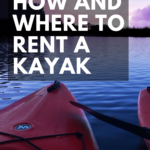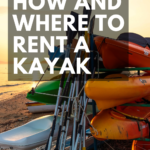Kayaking is a great way to get out on the water, experience nature, and get an enjoyable workout. But the high costs of quality kayaks make trying before buying a must.
Check out these top tips on where to rent from, what to bring, and what to expect before you head out to begin your paddling journey!
In my years as a camp counselor and lifeguard, I often had to break up fights over who’s turn it was to take a kayak for the Open Boating activity period. Our camp had canoes (both aluminum and fiberglass), stand-up paddle boards, pedal boats, and even a few small sailboats, but the kayaks were always the most desirable.
Kayaking is the most popular paddle sport (as supported by this report from The Outdoor Foundation), and for many good reasons.
Table of Contents
Why are Kayaks So Popular?
Kayaks let you cruise confidently through the water with very little effort. Like any paddled boat, they’re quiet and have a very shallow draft, letting you sneak up on turtles, fish, and frogs. The low angle of kayak paddle blades entering the water lets you continue paddling in much shallower water than a canoe can, making them the shallowest boats available.
Kayaks are also much more stable than many people believe. A canoe has a large, flat bottom that sits level on the water easily, but once you get it tipping, it’s very hard to save a canoe from going over.
A kayak has a more rounded bottom that doesn’t stick to flat near as much, but is more forgiving if you start tipping. The foot pegs and thigh braces give you a much better connection with the boat, making it easier to control the boat. That connection can be leveraged to help turn a long boat faster by tipping it up on its side, and even allows whitewater paddlers to roll a capsized kayak right back upright.
The range of sizes and styles of kayak, from little 5′ whitewater and creek boats, up to 20’+ sea kayaks, means that skills learned in one boat and type of water are highly transferable to other experiences.
For most of us a recreational kayak in the 10′ – 12′ range with a nice, large cockpit can lead to some great relaxing paddling on slow rivers and lakes.
Unfortunately, the high price of quality kayaks can put first paddling experiences out of reach for many would-be paddlers.
Don’t be tempted by the cheap, low-quality “kayaks” available at big-box stores today. They’re uncomfortable to paddle, and will not hold up to even light ordinary use.
Try paddling a few times, and if you decide it’s for you, try to find a quality used boat, or a good sale on a new one. Many rental outfits sell off their fleet regularly to grab the newest boats, so watch for those sales at the end of the summer.
The best way to get started kayaking is to go paddling with a friend, borrowing a boat from them. Failing that, head out to a reputable kayak rental outfit and rent your gear for the day, or for a weekend outing.
What’s Included in a Typical Kayak Rental?
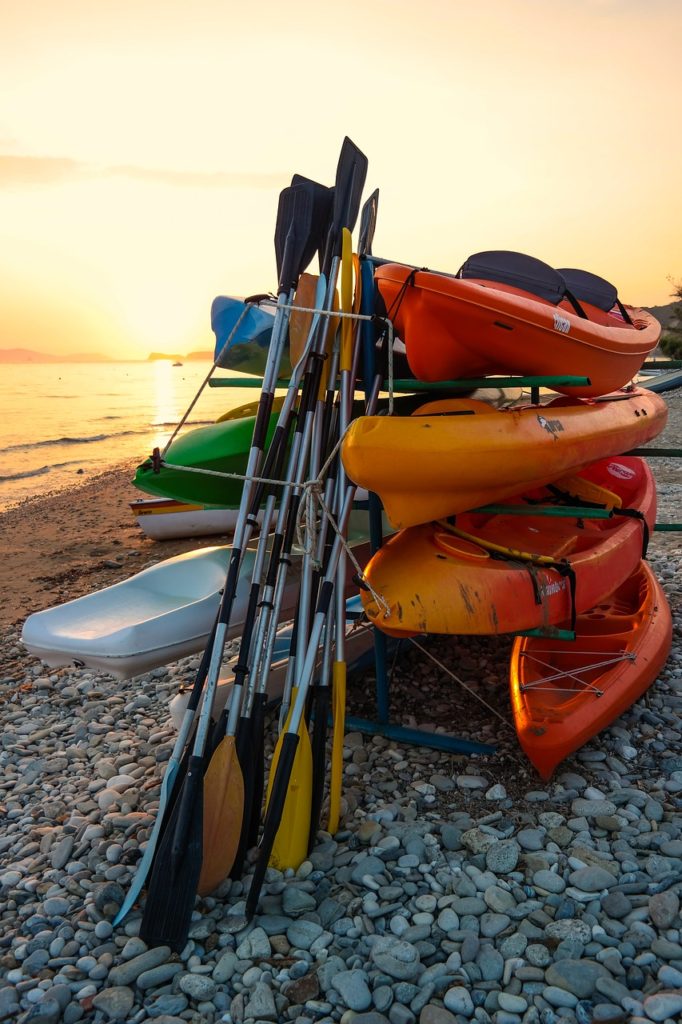
When you rent a kayak, you should expect three things to be included: a lifejacket, a paddle, and the kayak itself.
Kayak rentals come in three flavors: beachfront, where renters paddle on the body of water the outfit is located on; shuttle service, where renters are transported to a drop-off site and picked up downriver; and take-away, where renters pick up boats and transport them off-site themselves. One vendor may offer several options for rentals.
Life Jacket
I absolutely always wear a life jacket, and highly encourage you to do the same. The human body is a fragile thing, and it doesn’t take much of an injury to turn even the best of swimmers into total non-swimmers.
In many places, it’s illegal to paddle without a lifejacket, but these laws to vary from state to state. If you’re unsure of the laws on life jackets in your area, head on over to the Boat U.S. Foundation map of current life jacket laws by state.
Making sure you have a well-fitted life jacket made for paddling can make your experience much more enjoyable. Not every kayak rental outfitter has good life jackets available, even the good ones, so it pays to check ahead and bring your own if they don’t.
Kayak Paddle
Kayak paddles come in a variety of shapes, lengths, and materials. Whitewater paddles have very bendy/curvy shafts, while Greenland Kayak Paddles (a very easy to make option if you’d like to make your own paddle) hardly have any defined blade at all. Paddles designed for use in windy conditions may have feathered blades, blades that are twisted relative to each other, to help the top blade slice through the air.
Beginning paddlers will want a straight-shaft plastic and aluminum kayak paddle, not feathered, and just long enough that you can stand it on end and wrap your fingers over the end of the top blade. Take your time when picking through the paddle rack at the rental outfit, as a paddle that’s the wrong size can make paddling much less enjoyable.
The Kayak Itself
You might get some choice in this, or you might not. Some renters have a whole fleet of different boats to choose from, while others have racks filled with identical boats.
If you’re lucky enough to get a choice in the matter, opt for something 10′-12′ long for your first try, and you can experiment from there. Wider, more open boats tend to be much more comfortable for the beginner.
In my mind, the Wilderness Systems Pungo 120 is the ideal starter boat for anyone planning to paddle small lakes and relatively calm streams and rivers. They’re not cheap, retailing at about $1000 new, but if you can find one used or on a good sale, snap it up in a hurry. They’ve been the most popular boat for years at my friend’s local kayak shop, and are always a favorite at the free kayak demos they put on for the public.
If you’re not renting from a Wilderness Systems dealer, grab the local equivalent of the Pungo, like the Perception JoyRide 12′, or the Dagger Axis 12.0. About 12′ long, fairly wide at about 27″-28″ of beam, with a nice open cockpit. You won’t want to start out with a sit-on-top kayak, as they handle a little differently, but they’re a long-term favorite with fishermen.
Shuttle Services
If you’re renting from somewhere with a shuttle service, expect to pay for it. The shuttle isn’t their primary revenue stream, but it does cost them to staff it and maintain vehicles.
Make sure you know if the same vehicle is picking you up at the end, or a different one. Leaving things like towels and a change of clothes with the shuttle is a great idea if it will be the same van at the pick-up.
What to Bring When Renting a Kayak
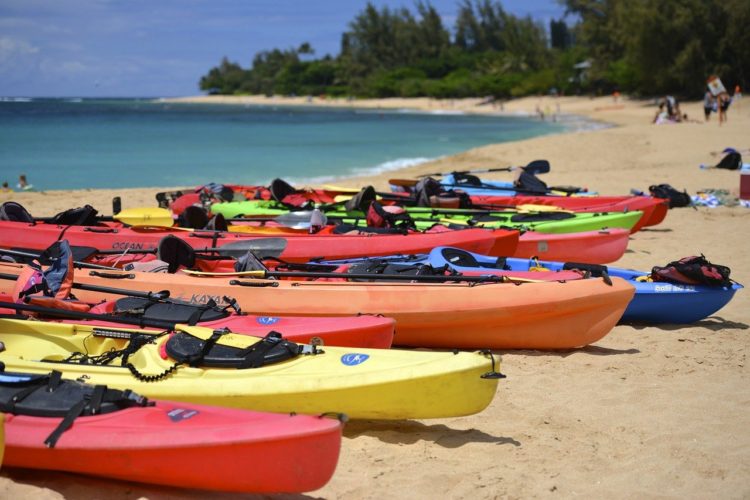
Below is a basic list of items to consider bringing along whenever you kayak, and especially when renting or trying out for the first time.
Keep in mind that anything you bring in the kayak with you has potential to get wet. There’s a lot of finesse you’ll learn along the way to keep you getting wet when kayaking, but those awkward few times you’ll probably be dripping some water in your lap from the paddle blades, or you might even go for an unplanned swim.
Do not bring anything in the kayak with you that will be damaged by water without taking precautions. A waterproof phone case or bag (grab the Stash Waterpocket off Amazon, most of the others are the same cheap junk rebranded a dozen ways) is a great way to protect your phone on any paddling trip, just make sure it floats ahead of time.
For the rest of your gear, an affordable entry-level dry bag is the best option, short of leaving it on shore. The SealLine Blocker is my choice for a cheap one, just keep in mind that it’s not going to hold up to getting beat around in the water quite as much as some of the higher-end ones will.
Remember, this is the basic list for an easy day paddling. If you’re heading out on something more adventurous, like some off-shore sea kayaking, go read through my article on Packing for a Sea Kayaking Trip.
The Paddling Gear List:
- Sponge or Towel – To wipe out any leftover sand or water from the last renter
- Bug Spray & Sun Screen – Water attracts insects, and the sun reflects off the water and will toast right through your base tan
- Hat – To protect your face from the sun
- Sunglasses
- Floating Glasses Strap – If you’re not using gas station sunglasses
- Dry Bag & Phone Case – If you choose to bring these things on the water
- A towel and change of clothes – In case you fall in or want to change out of those pants your paddle dripped a bit on
- Headlamp – Just in case you’re still on the water when night falls
- (Straps for Car-Topping if it’s a Take-Away rental)
What does Renting a Kayak Cost?
As with most outdoor activities, location is a big factor in cost. For most of the country, expect to pay $40-60 for a basic rental of a kayak, paddle, and life jacket for 4 hours to one day of rental duration.
The base price will depend a lot on the business model of the company you rent from. Retailers renting boats to help people try before they buy can afford to charge much less than rental-only companies who need to pay the bills just off revenue from rentals.
Many kayak retailers offer free kayak demos to let people try out a variety of boats before making the decision to purchase. If you can find one of those, definitely start there.
If you’re renting in a really popular area, expect to pay more. Shuttle services will also cost extra. Some outfitters. like REI, offer different tiers of boats for rent, with higher prices for more premium brand and style kayak.
If rental price is your deciding factor, spend a little time online looking up options in the area, and don’t be afraid to give them a call if rates aren’t listed online.
Basic Kayaking Skills
Getting around in a kayak is pretty easy, and somehow more intuitive than using a canoe.
Always paddle with a buddy. Any adventure sport with water involved should not be attempted alone, including SCUBA or any kind of paddling.
Getting into the Kayak
Set your foot pegs before you go anywhere. If you’re launching from a grassy shore or beach, sit down in the kayak on shore and set them before you even put the boat in the water. Foot pegs should be set so that your legs are nearly straight, but slightly bent.
If there are thigh braces in your boat, try to set the foot pegs so that you can comfortably tuck your thighs up into the braces, but easily swing your knees inward towards the center-line of the boat to escape if you tip.
Climb into your kayak, having someone help you if at all possible. Stay low, go slow, and get all ready and situated before you shove off land. If you need to launch yourself, find some shallow water and lay your paddle behind the cockpit, braced against the back deck of the kayak and the ground to act as a kickstand.
What To Do if You Tip Your Kayak
It’s entirely possible you could tip your kayak on your first trip. When I first tried out canoeing, I tipped before I’d made it more than about 30 feet down the river. Expect that you may fall out on your first few kayaking adventures. Dress accordingly, and stay close to shore.
If you flip your kayak, the first and most important thing is to get out of the kayak and get your head above water. With most recreational kayaks, you would have a tough time staying in the boat as it flipped, even if you wanted to.
However, if you do find yourself upside-down and still stuck, tuck your knees in towards each other, grasp the rim of the cockpit with both hands, and push yourself free. Anyone kayaking with a spray skirt might need to reach forward to the front of their skirt and release it from the combing as well.
Once you’re free, make sure you’re upstream of the boat if you’re in any kind of moving water. Even very slow streams can exert a tremendous amount of force on a boat, and you do not want to be the recipient of that force holding you under water or crushing you into a rock or tree.
Gather up your belongings, toss them back in the swamped kayak, and start swimming or wading to shore. Drag the kayak to shore, pull out your belongings, and dump out the water. Hop back in and you’re ready to keep paddling.
If you’re with an experienced paddler on open water, there are easier ways to rescue a boat, but they can take some practice to nail down.
Basic Kayaking Paddle Strokes
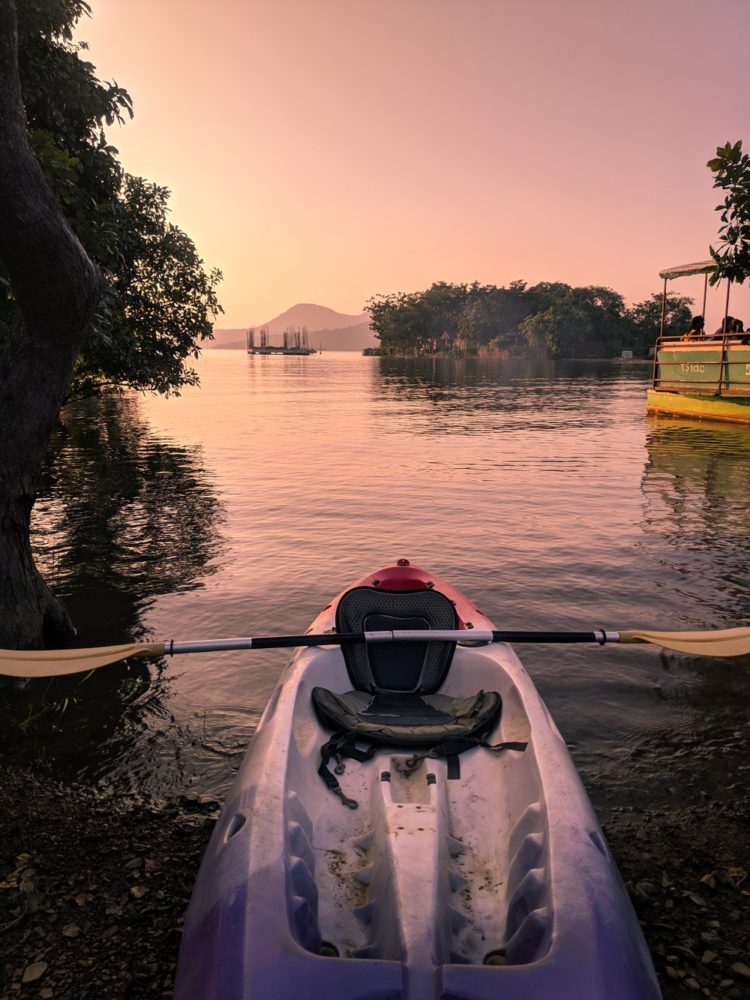
The forward stroke has you reach forward with one paddle blade, dip it in the water about level with your ankles, and pull it backwards through the water. Lift the blade up cleanly out of the water as it passes your hip, which should set your other blade about level with your other ankle, ready to enter the water.
To slow down or back up, just reverse the forward stroke. Insert your paddle blade into the water level with your hip, and push forward on it lifting it up out of the water as it approaches your ankles. Alternate sides that you paddle on to go straight backwards.
Turning a kayak can be done many ways, but the simplest is to just repeat the forward or reverse stroke over and over on one side of the boat. This will propel the boat forward and turn you in a gentle arc away from the side you’re paddling on.
To turn faster while remaining in place, paddle forward on one side, backwards on the other.
Any turning stroke can be made stronger by locking out your elbows, pushing the paddle away to the side, which lets the blade trace a larger arc in the water.
Kayak Rental Locations Mapped
There are kayak rental outfitters all over the country, all it takes is a Google or Google Maps search to find them. I built you an automatic search map below that will pull up top-rated kayak rental shops near you with just one click.
Know as well that some national chains, like REI, have rentals at all locations, and keep an eye out for local rentals from universities. You don’t need to have any affiliation at all with most of those set-ups, and I’ve always found their rates to be more reasonable than lots of other places.
Get Out There!
Try to aim for a nice, warm day for your first kayaking trip, but as you grow more experienced, you’ll push out your paddling season start and end dates.
Always make sure you have a plan for if things go wrong and you take a swim, especially in cold water.


